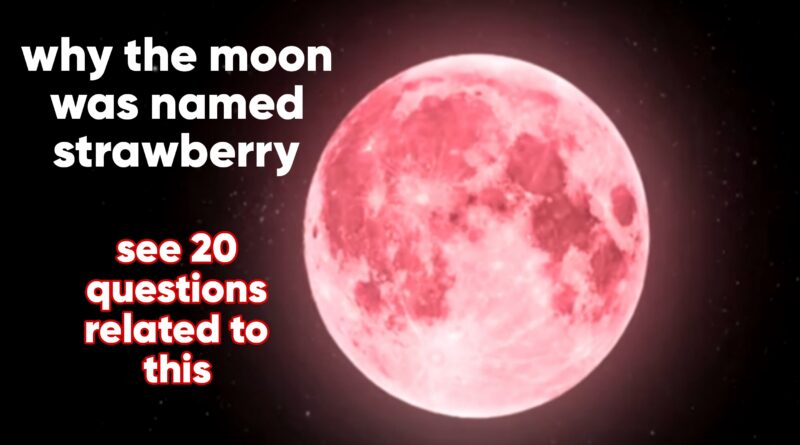Strawberry Moon 2025: 20 Most popular Questions Answered
Strawberry Moon 2025: 20 Frequently Asked Questions Answered
📌 Table of Contents
- 1. What is a Strawberry Moon?
- 2. When will the Strawberry Moon appear in 2025?
- 3. How to identify the Strawberry Moon?
- 4. Why is it called the Strawberry Moon?
- 5. Does it occur every year?
- 6. Will the Strawberry Moon be pink?
- 7. Is the Strawberry Moon rare?
- 8. Can I see the Strawberry Moon from India?
- 9. Is it safe to watch the Strawberry Moon with naked eyes?
- 10. What’s the best time to view the Strawberry Moon?
- 11. Can I photograph the Strawberry Moon?
- 12. What is the spiritual meaning of the Strawberry Moon?
- 13. Is the Strawberry Moon the same as a Supermoon?
- 14. Will there be a lunar eclipse during the Strawberry Moon?
- 15. Can I host a moon-viewing party?
- 16. Are there any myths or legends?
- 17. What direction should I look?
- 18. Can clouds block the view?
- 19. Is it related to strawberries?
- 20. What to do during the Strawberry Moon?
1. What is a Strawberry Moon?
The Strawberry Moon is the name given to the full moon that occurs in the month of June. This name originated from the Algonquin tribes of North America, who used it to signal the time of year when strawberries were ripe for harvesting. Contrary to popular belief, the name has nothing to do with the moon’s color. It doesn’t actually appear pink or red (although under certain atmospheric conditions, it might take on a golden or reddish hue). The Strawberry Moon is a cultural marker and has significance in both astronomy and folklore. In many traditions, it represents a time of abundance, transformation, and preparation for the summer season. Modern skywatchers celebrate it for its brightness and beauty, especially when it rises low on the horizon and appears larger than usual.

2. When will the Strawberry Moon appear in 2025?
The Strawberry Moon in 2025 will be visible on June 11, with the moon reaching full illumination at 3:44 AM Eastern Time. However, moonrise will start on the evening of June 10, giving viewers in most parts of the world the opportunity to see it. The best time to watch the moon is shortly after moonrise, when it’s low on the horizon and appears larger due to the “moon illusion.” Visibility depends on your region and weather conditions. Clear skies will offer the best view. You can use astronomy apps to check moonrise times in your city. Make sure to plan your viewing for areas with minimal light pollution for a better experience.
3. How to identify the Strawberry Moon?
To identify the Strawberry Moon, look for the full moon that occurs in June. It doesn’t have a unique color or texture, but it holds seasonal significance. It often appears golden or orange when it first rises, especially when near the horizon. This coloration is due to Earth’s atmosphere scattering shorter wavelengths of light. You can track its exact rise time using apps like Sky Guide, Star Walk, or Google Sky Map. Observing it in areas with minimal artificial lighting will enhance the experience. Although it looks like a typical full moon, its association with the summer harvest gives it special meaning. Remember, it’s best viewed in the early evening when it just starts to rise in the east.
4. Why is it called the Strawberry Moon?
The name “Strawberry Moon” originated from Native American tribes, particularly the Algonquin people. They used lunar cycles to track time and named each full moon based on seasonal activities. The June full moon signaled the peak time for harvesting wild strawberries. While the moon itself doesn’t appear red or pink, the name is symbolic of the summer harvest season. In Europe, it is also known as the Rose Moon or the Honey Moon, connecting it with weddings and the blooming of roses in June. These names reflect different cultural interpretations tied to seasonal changes. Today, the term has become popular among skywatchers and nature enthusiasts for its poetic meaning.
5. Does it occur every year?
Yes, the Strawberry Moon occurs every year during the full moon phase in June. It’s a consistent part of the lunar calendar and is celebrated by different cultures for its seasonal significance. Since the lunar cycle repeats approximately every 29.5 days, there’s always one full moon in June. While the name and its significance remain the same, the exact date and time of the Strawberry Moon shift each year based on the moon’s orbit and your local time zone. It can also sometimes align with special events like a supermoon or a lunar eclipse, which can make it even more unique in some years.
6. Will the Strawberry Moon be pink?
No, the Strawberry Moon does not actually appear pink in color. The name “Strawberry” is symbolic and refers to the timing of the wild strawberry harvest in June, not the color of the moon. However, sometimes the moon can appear orange, gold, or even reddish depending on atmospheric conditions, especially when it’s near the horizon at moonrise or moonset. This is caused by the scattering of shorter blue light wavelengths, allowing more reds and oranges to reach your eyes. But under normal viewing conditions, the Strawberry Moon will look like a regular full moon with perhaps a warmer tint.
7. Is the Strawberry Moon rare?
The Strawberry Moon itself is not rare—it occurs annually in June. However, its rarity can be heightened if it coincides with other celestial events such as a lunar eclipse, a supermoon, or if it falls on the summer solstice. These overlapping phenomena can make a particular year’s Strawberry Moon feel extra special. While the event itself is predictable and happens every year, the conditions around it, such as visibility, moonrise timing, or coinciding events, may vary and create rare viewing experiences. Many people mark their calendars for it each year because of its rich folklore and seasonal meaning.
8. Can I see the Strawberry Moon from India?
Yes, the Strawberry Moon is visible from India and can be seen from most parts of the country, provided the sky is clear. It usually rises in the eastern sky just after sunset and is easily visible throughout the night. Since India follows Indian Standard Time (IST), the moonrise time will be slightly ahead of locations in Europe or America. To get the exact moonrise time in your city, use astronomy apps or consult online moon calendars. Cities with less pollution and fewer lights, such as rural areas or hill stations, offer better viewing experiences. You don’t need any special equipment—just step outside and look east after sunset.
9. Is it safe to watch the Strawberry Moon with naked eyes?
Absolutely, watching the Strawberry Moon with your naked eyes is completely safe. Unlike solar eclipses, which can damage your eyes if viewed directly, the full moon poses no risk. In fact, it’s one of the easiest and most beautiful celestial events to enjoy without any special equipment. You don’t need binoculars or a telescope, though these tools can enhance your viewing experience. For the best visibility, find a dark place away from city lights. Clear skies, minimal pollution, and low humidity will all contribute to a better view. It’s a great opportunity for families, photographers, and nature lovers to enjoy the beauty of the night sky.
10. What’s the best time to view the Strawberry Moon?
The best time to view the Strawberry Moon is shortly after moonrise, which typically happens around sunset. This is when the moon appears largest and most colorful due to the “moon illusion.” When near the horizon, the moon can take on hues of orange or gold, creating a dramatic and beautiful scene for photography and observation. To find out the exact moonrise time in your area, use apps like Sky Guide, Stellarium, or TimeandDate.com. Viewing is also ideal late at night when the moon is high in the sky, especially in areas with low light pollution. Always check local weather forecasts for cloud cover before planning your night under the stars.
11. Can I photograph the Strawberry Moon?
Yes, you can photograph the Strawberry Moon with a basic smartphone or DSLR camera. For better results, use a tripod to avoid blurriness and enable night mode or manual settings to control exposure and focus. Zoom lenses or telescopes with camera adapters can provide detailed shots. The best time to take photos is at moonrise or moonset, when the moon appears larger and more colorful due to atmospheric scattering. Try including landscape elements like trees, mountains, or buildings to create a more dramatic composition. Use editing apps to enhance brightness and contrast if needed. Don’t forget to check weather forecasts and plan your location in advance.
12. What is the spiritual meaning of the Strawberry Moon?
Spiritually, the Strawberry Moon is seen as a time of renewal, growth, and emotional cleansing. Many believe it’s a powerful moment to release old habits and embrace change. In Native American traditions, it marked the season of abundance and gratitude for nature’s harvest. In modern spiritual practices, full moons are believed to amplify energies, making it a good time for meditation, manifestation, and reflection. People often write intentions or perform cleansing rituals under the moonlight. The Strawberry Moon specifically encourages focus on love, relationships, and nurturing emotional well-being. Whether or not you follow spiritual beliefs, it’s a beautiful reminder of cycles and transformation in nature.
13. Is the Strawberry Moon the same as a Supermoon?
Not always. A Supermoon occurs when a full moon coincides with the moon’s closest point to Earth (perigee), making it appear larger and brighter than usual. The Strawberry Moon can sometimes be a Supermoon, but not every year. In years when the full moon in June aligns with perigee, it’s called a “Strawberry Supermoon,” and that’s considered a more rare and visually impressive event. When this happens, the moon can appear up to 14% larger and 30% brighter. Check astronomical calendars or NASA updates to know if the upcoming Strawberry Moon qualifies as a Supermoon.
14. Will there be a lunar eclipse during the Strawberry Moon?
There isn’t always a lunar eclipse during the Strawberry Moon. A lunar eclipse happens when the Earth comes between the Sun and the Moon, casting a shadow on the Moon. This is a separate event from the regular full moon phase. However, on rare occasions, the June full moon can coincide with a lunar eclipse. When it does, it’s a spectacular sight and often referred to as a “blood moon” due to its reddish color during the eclipse. To find out if the upcoming Strawberry Moon will feature a lunar eclipse, check resources like NASA’s lunar calendar or space news websites.
15. Can I host a moon-viewing party?
Yes! Hosting a moon-viewing party during the Strawberry Moon is a fun and memorable way to enjoy this celestial event. Choose a spot with clear views of the eastern horizon, ideally away from city lights. You can set up blankets, telescopes, binoculars, and snacks. Consider adding some music or a small fire pit for ambiance. Encourage guests to bring cameras or sketchpads to capture the moon. You can also incorporate storytelling, lunar trivia games, or even a meditation session. The event is suitable for families, couples, or friend groups and provides a relaxing way to connect with nature and each other.
16. Are there any myths or legends?
Yes, many cultures have myths and legends associated with full moons, including the Strawberry Moon. Native American tribes linked it to fertility, harvest, and feminine energy. In European folklore, it was considered a time of heightened romance and emotional clarity. Some believe that wishes made under the Strawberry Moon come true, while others think it enhances psychic abilities. Farmers historically believed it was a good time to plant or harvest crops. Though not scientifically proven, these legends add richness and mystery to the lunar event. Today, many people still honor full moon traditions with rituals, journaling, or quiet reflection.
17. What direction should I look?
To see the Strawberry Moon, look toward the eastern horizon shortly after sunset. That’s where the moon typically rises. As the night progresses, it moves higher in the sky, eventually heading west by dawn. If you want to catch the dramatic “moon illusion,” try viewing it just as it rises. Apps like SkyView or Star Walk can help you locate its exact position in real time. You don’t need a telescope—just a clear line of sight and ideally a location away from city lights. If possible, watch from a hilltop or open field for an unobstructed view.
18. Can clouds block the view?
Yes, clouds can definitely obstruct your view of the Strawberry Moon. Overcast skies, heavy clouds, or even light haze can reduce visibility or completely hide the moon. That’s why checking the local weather forecast before planning your moon-viewing is essential. High-altitude clouds may still allow partial views, but lower, thicker clouds can block the moon entirely. If the weather isn’t favorable, you can try watching live streams of the moon from observatories or space organizations online. Apps like AccuWeather and Windy can provide detailed cloud coverage predictions to help you plan accordingly.
19. Is it related to strawberries?
Yes, the name “Strawberry Moon” is directly related to the seasonal harvest of strawberries. It marked the time when Native American tribes would gather ripened strawberries in June. Although the moon itself doesn’t resemble or reference the fruit visually, the name commemorates an important agricultural season. In modern times, the name has become symbolic of summer’s arrival, abundance, and sweetness. Some communities even hold strawberry festivals around this time, blending lunar traditions with local culture. It’s a charming example of how nature and astronomy influence human traditions.
20. What to do during the Strawberry Moon?
During the Strawberry Moon, consider activities that connect you with nature and reflection. Go moon-gazing with friends or family, host a picnic under the stars, or practice meditation. It’s also a perfect time for journaling your intentions, releasing negative energy, or simply appreciating the sky’s beauty. Photographers can capture the moon with landscapes, while spiritual practitioners may hold full moon rituals. If you’re interested in astrology, you might use the energy of the moon to set goals or recharge crystals. Whether spiritual, recreational, or social, there are countless ways to celebrate this lunar event meaningfully.










Leave a Reply